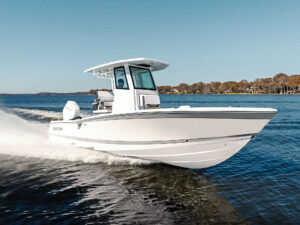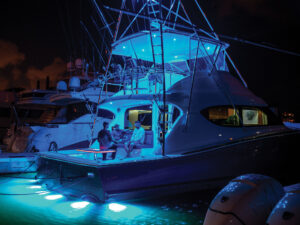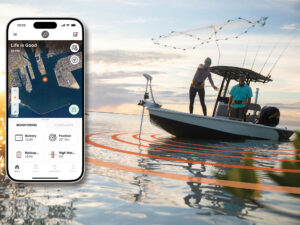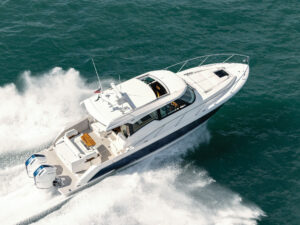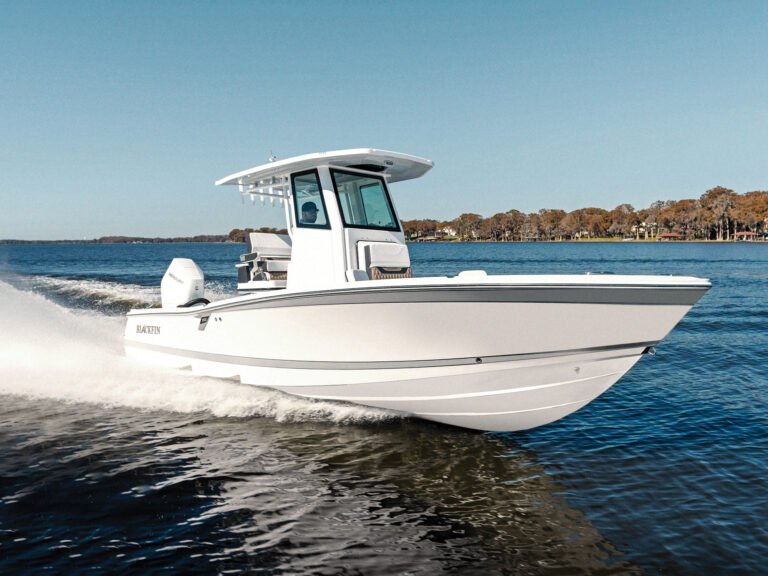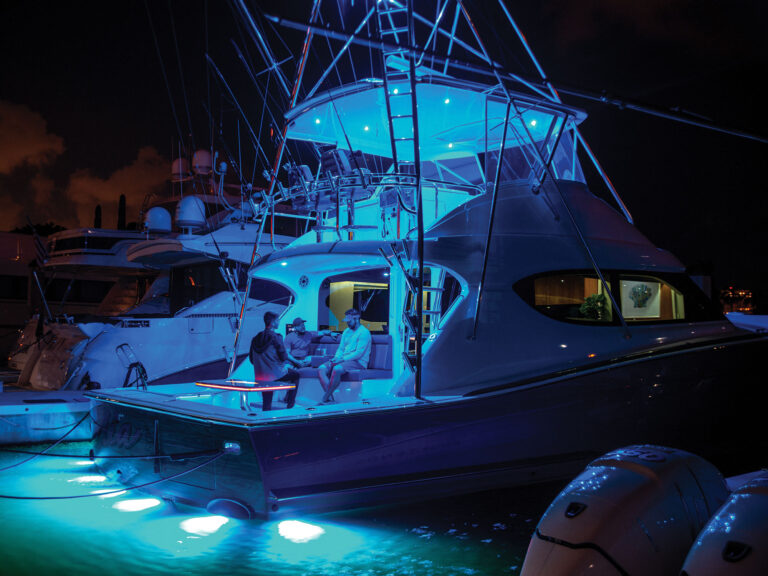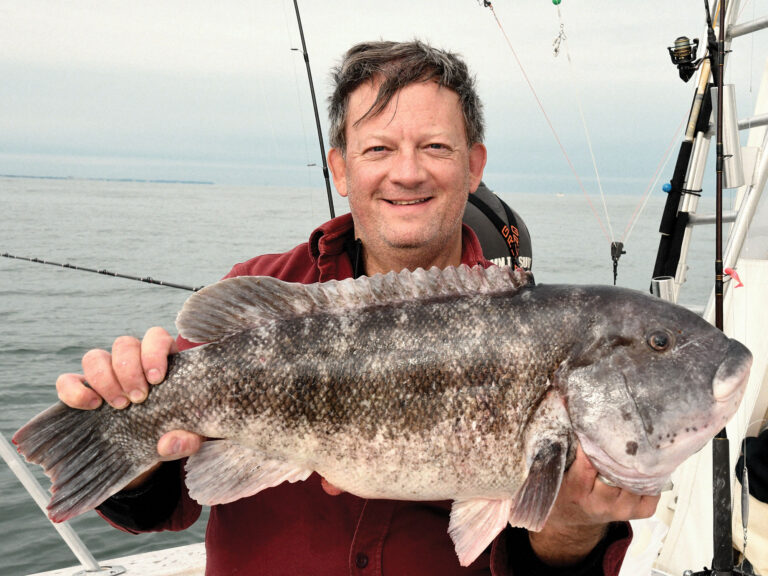
Arriving at the launch ramp near the inlet to the Atlantic Ocean, we were greeted by an angry St. Johns River in Jacksonville, Florida. It rumpled with confused 3-foot seas and frosted whitecaps thanks to a 30 mph northeast wind clashing with an outgoing tide. These conditions would typically be a no-go call for me, but it provided perfect conditions to test a Sportsman 262 Open center-console equipped with a Seakeeper 1 gyrostabilizer combined with Seakeeper’s Ride 525, a transom-mounted control system that reduces up to 70 percent of pitch—the up-and-down motion at the bow. The gyro reduces roll on a boat by up to 90 percent and is most noticeable when the boat is not moving or going at slow speeds, like when trolling.
Years in Development
When Seakeeper co-founders Shepard “Shep” McKenney and John Adams introduced their first gyrostabilizer in 2008, it had been under development for five years before hitting the market. It was greeted by a lukewarm reception due to high cost and an attitude of hardcore anglers who said boat roll didn’t bother them. As the years progressed, their gyros got smaller and less expensive and started filtering down to more compact and popular boats, including center-console fishing models. Our gyro was mounted on the deck, under the leaning post, eliminating the need to find space belowdecks. Currently, Seakeeper is conducting demos on a Boston Whaler 22-foot Outrage with both systems and, eventually, boaters can expect to see them on boats of all sizes.
The road to Ride’s arrival on the market in 2023 was even longer, according to Seakeeper president and CEO Andrew Semprevivo. “It was always the vision of Seakeeper to control motion across all axes, at all speeds, and on boats of all sizes. By 2020—after 15 years of research and development financed by gyro profits—we had a high-performing prototype of the Ride system, but it would have cost $50,000. So for the next three years, our mission was to reduce costs without affecting performance.”
What is Ride?
First, don’t call them trim tabs; Seakeeper calls Ride a “vessel-attitude control system” that uses cupped, curved rotary blades moved by high-speed actuators to make up to 100 corrections a second at speed. The Ride’s brain senses pitch, roll and yaw, as well as speed. Using this data, the brain sends instructions to the actuators to control the boat on all three axes. When a boat is on plane, the rotary motions of the blades are mere fractions of an inch, controlled by sophisticated software. Because so little of the blade touches the water, there is minimal drag, which doesn’t significantly affect speed or fuel economy in light seas. When it gets rougher, testing indicates that fuel economy can actually improve.
Shoving off into the maelstrom, we first ran downsea with the gyro locked and the Ride system off. Without any assists to counteract roll, the boat would heel over occasionally when cresting larger waves, and the bow would point down and move sideways, causing it to bow-steer in an unintended direction. When we turned on the Ride system by itself, the boat’s tendency to heel diminished considerably, and the bow’s up-and-down motion leveled out significantly. Turning on the gyro with Ride elicited a subtle improvement that Seakeeper literature says equals about a 20 percent improvement in roll control when on plane. To me, it felt like the deck became more earthlike. Most captains will shut down the gyro during long runs to keep its hours low.
Read Next: Is Seakeeper’s Ride System Really Better Than Trim Tabs?

Sea-Trial Results
While cruising into the waves with both systems disabled, the ride was harsh with a lot of bow oscillation, causing the hull’s flatter middle section to bang against the waves. Legs became active shock absorbers, and it’s easy to see how fatigue would be an issue over long hauls across open water. Engaging the Ride system dramatically reduced the pitching motion. What impressed me the most was that corrections never seemed reactive; they happened before you could sense a need. Walking around the boat while underway did not affect its running attitude, nor did it heel over.
Going beam to the waves was a nonevent. While the boat would lean over a bit when cresting a wave, there was never that, “Whoa, here we go,” feeling of tippiness. A helpful feature is the ability to make manual corrections for tasks while Ride is engaged, like reducing spray in quartering seas, but helmsmen will seldom see the need to touch the Ride controls.
Cruising around a bend in the St. Johns put us in the lee of the blow, allowing us to go faster and make hard turns without getting a face full of spray. Despite the ride-leveling forces, the boat could still carve turns at speed in a natural manner. I never felt the gyro or Ride’s blades pushing back. The hull leaned in turns comfortably.
What does all of this cost? The Seakeeper 1 gyro is a pricy $30,242 option on the Sportsman. The Ride 525 was a standard feature, but this system retails in the aftermarket for $7,500 (not including installation). Instead, you might consider the more affordable Ride 450 system, which is suitable for boats 26 feet or less, for $4,500 (plus installation). Ride systems are available on boats up to 42 feet long.
There are other automatic attitude-control systems on the market, including Bennett’s Auto Trim and Lenco’s Auto Glide Boat Leveling. Both are trim-tab-based systems that control pitch and roll while underway. While less expensive than Ride, they are also slower to correct imbalances and bow oscillation. Zipwake uses vertical blade interceptors, a motion controller and gyro sensors to keep a boat running on an even keel, and is faster than the trim-tab systems mentioned.
Quick makes a wide variety of gyroscopes that don’t require water cooling, lowering installation costs. The newest gyro on the block comes from Dometic—the DG3—which has a host of innovations like regenerative braking to recharge the battery during spool-down.
The Verdict
Small, narrow boats with a lot of deadrise will see the most dramatic increases in stability when employing both Seakeeper systems. During tests in similar conditions, this combination of systems showed a 68 percent improvement in pitch control and a 44 percent roll reduction. The short answer is that Seakeeper’s gyro and Ride system combine to make boats perform like larger vessels and create the illusion the seas are half their size. Expensive? Yes. Worth it? Definitely.

